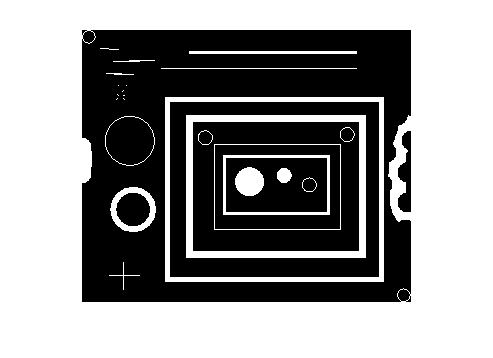Customizing REGIONPROPS With Your Own Measurements
I saw a presentation last month that mentioned a user request to have the ability to customize regionprops. That is, a user wanted to be able to add their own measurement to regionprops.
Today, I'll show you how to do this yourself.
First, here's a brief recap on what regionprops does. The function computes measurements of image regions. Some of these measurements are based purely on a region's shape, while others incorporate pixel values within the regions. Here's an example using the coins.png sample image.
I = imread('coins.png');
imshow(I)

Let's convert this image to binary, using adaptive thresholding, filling holes, and removing small "noise" pixels.
bw = imbinarize(I,'adaptive'); bw = imfill(bw,'holes'); bw = bwareafilt(bw,[100 Inf]); imshow(bw)

You can count the "blobs" (object) yourself; there are 10 of them.
The simplest regionprops call, regionprops(bw) computes the Area, Centroid, and BoundingBox for each object.
s = regionprops(bw)
s =
10×1 struct array with fields:
Area
Centroid
BoundingBox
But I don't think this is the best way to call regionprops anymore. You can now tell regionprops to return the results as a table.
t = regionprops('table',bw)
t =
10×3 table
Area Centroid BoundingBox
____ ________________ ____________
2635 37.133 106.85 [1x4 double]
1846 56.131 49.693 [1x4 double]
2672 96.199 146.05 [1x4 double]
1839 109.97 84.848 [1x4 double]
2744 120.37 208.73 [1x4 double]
2520 148.57 34.404 [1x4 double]
2589 174.83 120.01 [1x4 double]
2518 216.81 70.649 [1x4 double]
1857 236.03 173.36 [1x4 double]
1829 265.96 102.64 [1x4 double]
The table form is a lot more convenient for many tasks. For today's topic, one especially nice thing thing about tables is how easy it is to add your own variables to the table.
To illustrate, let's add a measurement that I've seen called Roundness. One definition for roundness is:
$R = \frac{4A}{\pi L^2}$
where $A$ is the object area and $L$ is the major axis length of the best-fit ellipse for the object. Here's how to compute roundness and add it directly to the measurements returned by regionprops.
First, note that both Area and MajorAxisLength are supported by regionprops, so let's start with those.
t = regionprops('table',bw,'Area','MajorAxisLength')
t =
10×2 table
Area MajorAxisLength
____ _______________
2635 60.08
1846 50.178
2672 59.792
1839 49.674
2744 60.374
2520 58.08
2589 58.676
2518 58.162
1857 49.77
1829 49.564
You access table variables using dot notation, like t.Area. Similarly, you can create a new table variable using dot notation and assignment, like t.MyVariable = .... So adding Roundness to the table returned by regionprops is this simple.
t.Roundness = 4 * t.Area ./ (pi * t.MajorAxisLength.^2)
t =
10×3 table
Area MajorAxisLength Roundness
____ _______________ _________
2635 60.08 0.92945
1846 50.178 0.93352
2672 59.792 0.9516
1839 49.674 0.94893
2744 60.374 0.9585
2520 58.08 0.95118
2589 58.676 0.95745
2518 58.162 0.94772
1857 49.77 0.95453
1829 49.564 0.94798
Let's try this computation with an image containing objects that are not quite as round.
I2 = imread('rice.png');
imshow(I2)

bw2 = imbinarize(I2,'adaptive'); bw2 = imfill(bw2,'holes'); bw2 = bwareafilt(bw2,[100 Inf]); imshow(bw2)

t2 = regionprops('table',bw2,'Area','MajorAxisLength'); t2.Roundness = 4 * t2.Area ./ (pi * t2.MajorAxisLength.^2); head(t2)
ans =
8×3 table
Area MajorAxisLength Roundness
____ _______________ _________
138 23.594 0.31562
120 18.152 0.4637
169 28.123 0.27207
157 23.793 0.3531
284 43.757 0.18885
200 26.259 0.36929
141 21.647 0.38311
177 29.087 0.26636
I'm a big fan of the (relatively) new histogram function in MATLAB, so let's use it to compare our roundness numbers. I will follow the advice given in the histogram reference page for normalizing multiple histograms so that they can be more easily compared. I'll set the y-axis limits to [0 1], which is appropriate for probability normalization, and I'll set the x-axis limits to [0 1], which is the range for Roundness.
h1 = histogram(t.Roundness); hold on h2 = histogram(t2.Roundness); hold off h1.Normalization = 'probability'; h2.Normalization = 'probability'; h1.BinWidth = 0.02; h2.BinWidth = 0.02; xlim([0 1]); ylim([0 1]); title('Histogram of roundness (probability normalization)') legend('coins','rice')

There you have it. You can add your own object measurements to the output of regionprops. It's especially easy if you tell regionprops to return a table.
I'll leave you with this question, dear reader: Are there measurements you would like us to add to regionprops? I am aware of an enhancement request for the Feret diameter. What else would you like to see?









댓글
댓글을 남기려면 링크 를 클릭하여 MathWorks 계정에 로그인하거나 계정을 새로 만드십시오.